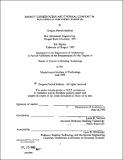Energy conservation and thermal comfort in buildings in northern Pakistan
Author(s)
Sullivan, Gregory Patrick
DownloadFull printable version (9.198Mb)
Other Contributors
Massachusetts Institute of Technology. Dept. of Architecture.
Advisor
Leslie K. Norford.
Terms of use
Metadata
Show full item recordAbstract
The Hunza Valley, a remote area of mountainous northern Pakistan, is undergoing rapid change culturally, socially, and architecturally. Many of these changes are linked to the exchange of information and commerce facilitated by the Karakoram Highway. This highway, completed in 1974, has allowed a culture and lifestyle dating back many of hundreds of years to be influenced by lower Pakistan and western cultures. Architecturally, these changes have led to the use of new, non-traditional, building material (concrete block and window glass) and new building designs which are climatically inappropriate and more consistent with the mild climate of lower Pakistan. This study examines these changes from an energy perspective in the homes and schools in and around Karimabad, a central village in the Hunza Valley. To assess baseline energy consumption, recorded indoor and outdoor temperature data for three homes and two schools were analyzed. These data were used with a steady state energy model to assess and compare energy consumption of a traditional and a modem home and assess energy conservation measures and design changes. The results showed a 30 percent reduction in heat loss in the traditional home compared to the modem home. This reduction is mostly due to the higher wall and roof thermal resistance values of the traditional home. Further insulation of the walls in both home types is recommended. In the case of the modem homes adding R-5 of rigid foam insulation is estimated to reduce heat loss by 46 percent, over the base case modem home, with a simple payback of 3.8 years. The use of windows is recommended on the south facing facade netting a simple payback of 3.9 years and the use of buried walls (into the north slope) and shared walls (cluster housing) were each estimated to save 17 percent over the standard modem home. Indigenous insulations were researched for use in homes and schools. Sawdust and straw were found to be the most practical and were used with a gluebinder to make 1.5"x 15"x 25" panels. These panels were tested in a flat screen thermal conductivity tester specifically built and calibrated for this study. The measured thermal resistance values were R-2.89/inch (+ /- 9.7 %) for the ...
Description
Thesis (M.S.)--Massachusetts Institute of Technology, Dept. of Architecture, 1995. Includes bibliographical references (leaves 158-159).
Date issued
1995Department
Massachusetts Institute of Technology. Department of ArchitecturePublisher
Massachusetts Institute of Technology
Keywords
Architecture.